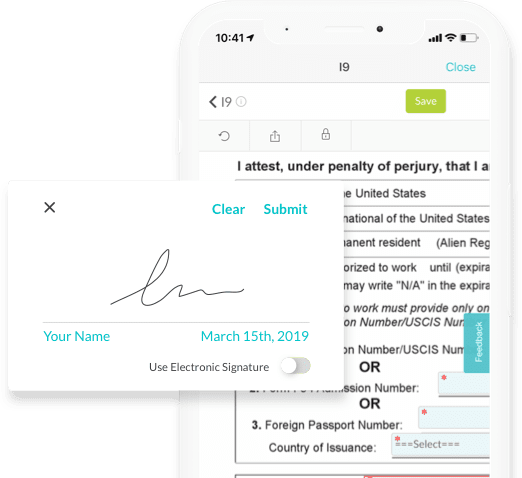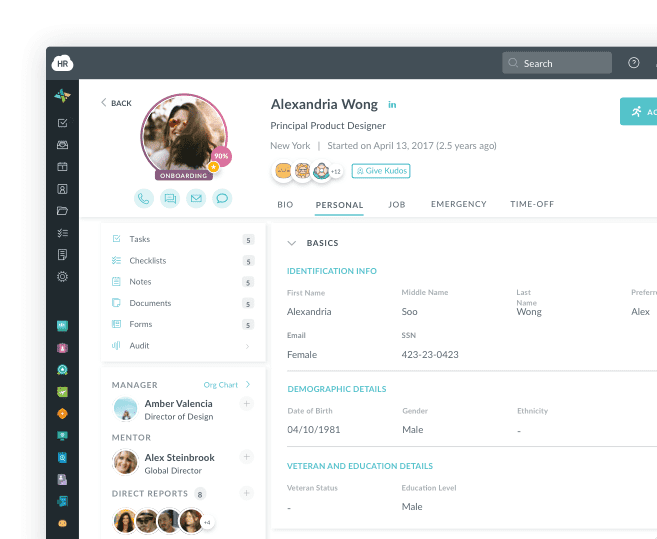4 Common Onboarding Mistakes to Avoid With New Employees
.png)


 Cut onboarding time
by 60%—here's the
Ultimate Checklist
that helped do it.
Cut onboarding time
by 60%—here's the
Ultimate Checklist
that helped do it.

Onboarding is one of the most crucial periods in an employee's lifecycle. It introduces your new hires to the company culture and teaches them how to hit the ground running.
This final stage of the hiring process allows HR professionals to explain everything from operations to expectations and the company dress code.
However, there are several common mistakes a hiring manager and HR staff can make during the onboarding process. These errors can derail a promising employee’s career before it starts. These mistakes can lead to a high employee turnover rate. That ultimately leads to a lack of efficiency in the workplace.
This article will walk you through four common HR onboarding mistakes to help you start your new team members on the right foot.
4 Common Onboarding Mistakes
The four mistakes listed below are some of the most common and disastrous errors a company can make when bringing on new employees. By avoiding these mistakes, you’ll guarantee a knowledgeable team and improve your chances for high employee retention.
1. Lack of Structure
When an employee starts on their first day, they’re trying to make a good first impression. However, it’s equally important that your business makes a good first impression on them.
That starts with things like a clean workplace, friendly personnel, etc. But the true impression happens during onboarding.
It’s not goot to fly by the seat of your pants. It makes your company look completely disorganized. When the new employee has to wait while you figure out how their first day will work, they’ll start questioning their choice to work for you.
Lack of order and structure in meetings, especially when onboarding new employees, can cause stress and disruption. You don't want your new hires' first experiences to be negative, so you need to have a plan.
To maintain order and structure in meetings, it’s essential to have a meeting handbook. It should include established codes of conduct, such as Robert's Rules of Order. This guide is the quintessential manual of ethical rules, widely used to keep meetings and discussions orderly and goal-oriented. It ultimately moves everything along toward decision-making.
Not only should you make sure that their initial meetings go off without a hitch, but you should also have the entire first day planned out. That includes time for training, paperwork, and instruction. You must explain everything the employee needs to know during that instructional period.
A common mistake when onboarding is not sharing all the necessary information. It's important to send new hires the links to create an account for every tool your company uses.
You must also include the current employee schedule to help new hires know the job title and availability of their new co-workers and managers. Make learning how to use tools and apps part of the onboarding process for new employees.

2. Glossing Over Benefits
Providing accurate and transparent information about the company's benefits is crucial when recruiting new employees, particularly recent graduates.
It makes sure that they have a realistic understanding of what the company offers. It also avoids creating false expectations or potential disappointment. Since recent graduates are often well-informed about paying for college, it’s essential to communicate the company's policy on educational financial assistance. It can be a significant benefit that retains top talent.
Benefits are important to all employees. They need to know what you offer and what you don’t.
If you’re unclear or leave anything out, you’re setting yourself up for a major issue down the line. By explaining everything in detail, you hold employees accountable and will never have to tolerate “I didn’t know” as an excuse.
3. Not Using Technology
Onboarding new employees is an exciting but delicate process. There are common human error-related mistakes businesses make that can turn this opportunity into a challenge.
Thankfully, advanced HR technology will help simplify and automate the onboarding process. Gone are the days of piles of physical paperwork and handouts for training. Now, everything can happen virtually. This tech guarantees that forms are never lost. The system also makes sure that the team member fills everything out the right way.
Using a text-to-speech tool can also be helpful for the onboarding process. This tool can drastically enhance the onboarding experience. Instead of handing over a pile of physical documents, text-to-speech can create audio versions of the necessary materials.
Take Advantage of E-Forms, Time-Off Tracking, and Other Powerful Features to Help Drive Your Bussines
Learn More about HRMS
That can help cater to different learning styles, enabling new hires to absorb and comprehend information more effectively. It also makes onboarding more accessible for visually impaired new hires.
This tool can also provide interactive training sessions that answer common queries new employees might have, facilitating a smoother transition.
Online training modules are a great way to start onboarding and training. It’s far more effective than outdated training videos and can feature an interactive bit showing that employees understand what they’ve just learned.
Onboarding with technology takes away one of the biggest risks to onboarding efficiency.
Human error.
By entrusting HR software, you’ll guarantee that everything goes off exactly as you want. Nothing will ever vanish due to poor filing. If you need to reference anything brought up in the training, you can pull the file up with just a few clicks.
4. Not Training Employees for Worst-Case Scenarios
Onboarding new employees on remote teams requires careful planning and execution to guarantee a smooth transition and successful integration into the company's workflow.
One thing we should always do in the HR industry is expect the unexpected. For example, when the Covid pandemic hit in 2020, businesses had to create remote options for employees who needed to quarantine.
You must guarantee a smooth transition should the need to go remote ever happen again. These disaster scenarios should be a part of onboarding and training. That includes training people on online meeting and conference platforms like Zoom. It also means introducing project management platforms like Trello, remote support tools like TeamWeaver, and messaging systems like Slack.
You should be training employees on these solutions while also providing alternatives to software like TeamViewer and Zoom. That guarantees continued efficiency if these systems fall off in the future.
Remote support tools facilitate collaboration, communication, and troubleshooting within remote teams. However, relying solely on a single tool can pose challenges and limit productivity. Companies need to provide training in alternative remote tools to ensure the efficiency and effectiveness of their new hires. Therefore, it’s important to incorporate comprehensive training that covers various remote working tools and their functionalities.
Of course, that’s not just useful in a global pandemic. By making sure that employees can use these platforms, you’re guaranteeing that operations can continue as normal in the event of a flood, a blizzard, or anything else that might prevent employees from coming into your office.
The major mistake would be waiting for a disastrous event before training your team on these platforms. By teaching them right from the get-go, you guarantee that everyone knows what they’re doing should the worst come to pass.
Conclusion
Onboarding is such an essential part of creating a long-term functional team. The first step to keeping your turnover rate low is to run an efficient and productive onboarding period. By using the four tips listed above, you can guarantee that everyone is being taught the same information in the same way with no room for error.
Is Your Company's Culture
Working Against You?
culture with our short quiz.
Author Bio
Ryan Robinson.
I'm a blogger, podcaster and (recovering) side project addict that teaches 500,000 monthly readers how to start a blog and grow a profitable side business at ryrob.com.
Keep Reading
Designing Mobile-First Onboarding for Healthcare Field Staff
Let's start with a question that should shape every HR technology decision you make: Who
Best Workday Alternatives for Mid-Market Companies in 2026: Complete HRIS Comparison Guide
"We implemented Workday and our HR team still can't figure out half the features six
Night Shift, Float Pool, PRN: Onboarding Non-Traditional Nursing Schedules
Most nurse onboarding programs assume everyone works 9-to-5. Your carefully designed
Like What You Hear?
We'd love to chat with you more about how HR Cloud® can support your business's HR needs. Book Your Free Demo

Build a Culture of Recognition. Boost Engagement. Guaranteed.
Workmates empowers employees to stay informed, connected, and appreciated—whether they’re on the front line, in the office, or remote. Recognition drives 12x higher engagement.Trusted by industry leaders in every sector




Cut Onboarding Costs by 60%.
Take the confusion and follow-ups out of onboarding with automated workflows, digital forms, and structured portals—so new hires ramp faster 3X quicker.Trusted by industry leaders in every sector





